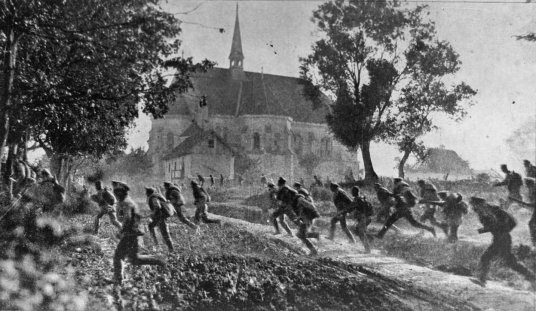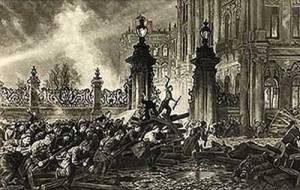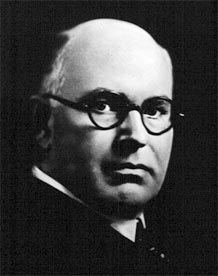 The ‘Provisional Government’ in Petrograd lurched from one crisis to another. With continuing heavy military defeats and ever-rising death toll, Russian troops and civilians called for an end to the madness. An All-Russian Peasant Congress, dominated by the socialist revolutionaries, was held in May in support of the provisional Government. A conference of Petrograd factory workers on the other hand, became the first representative body to support the Bolsheviks. It was a time of new beginnings and old grudges. The first All-Russian Congress of Soviets was held in June, with 822 vote-carrying delegates. 285 were Socialist Revolutionary Party, 248 Mensheviks and 105 Bolsheviks. The remaining 184 delegates belonged to various minority groups or had no party allegiance. Throughout the three week conference, Trotsky solidly supported the Bolsheviks. Congress, however, passed a vote of confidence in the Government, and rejected a Bolshevik resolution demanding ‘the transfer of all state power into the hands of the All-Russian Soviet of Workers, Soldiers and Peasants Deputies’. [1] Hamstrung and without any decisive power, the Provisional Government was open to attack from right and left. Lenin sensed a definitive opportunity.
The ‘Provisional Government’ in Petrograd lurched from one crisis to another. With continuing heavy military defeats and ever-rising death toll, Russian troops and civilians called for an end to the madness. An All-Russian Peasant Congress, dominated by the socialist revolutionaries, was held in May in support of the provisional Government. A conference of Petrograd factory workers on the other hand, became the first representative body to support the Bolsheviks. It was a time of new beginnings and old grudges. The first All-Russian Congress of Soviets was held in June, with 822 vote-carrying delegates. 285 were Socialist Revolutionary Party, 248 Mensheviks and 105 Bolsheviks. The remaining 184 delegates belonged to various minority groups or had no party allegiance. Throughout the three week conference, Trotsky solidly supported the Bolsheviks. Congress, however, passed a vote of confidence in the Government, and rejected a Bolshevik resolution demanding ‘the transfer of all state power into the hands of the All-Russian Soviet of Workers, Soldiers and Peasants Deputies’. [1] Hamstrung and without any decisive power, the Provisional Government was open to attack from right and left. Lenin sensed a definitive opportunity.
Four days of menacing street demonstrations that began on 3 July in Petrograd were widely believed to have been instigated by Lenin in an attempt to seize power. Troubles mounted. Prince Lvov resigned as premier and the Menshevik, Alexander Kerensky, took charge, promising the allies that Russia would remain committed to the war. Kerensky was scathing of Bolshevism and vice versa. He dubbed it ‘the socialism of poverty and hunger’, insisting that there could be no socialism without democracy. [2]
Trotsky, who had once sided with Kerensky, disagreed. He and around 4,000 fellow members of the Mezhrayonka, a faction holding an intermediate position between the ‘soft’ Mensheviks and the ‘hard’ Bolsheviks, sided with Lenin. Trotsky then chose to support the man he had previously attacked as a ‘despot’; a man whose political philosophy, he had claimed, ‘was based on lies and falsification’. It was Trotsky himself who foresaw that Lenin’s success would ‘lead to a dictatorship over the proletariat’ rather than ‘a victory of the proletariat’. And so it came to pass that Trotsky enabled his own prophecy. He was elected onto the Bolshevik central committee, polling a mere three votes less than Lenin himself. Strengthened by their political alliance, Lenin urged his Bolsheviks ‘to prepare for armed uprising’. Russia, he declared, was in the hands of a ‘dictatorship’. [3] The irony of his words remains awesome.
In August 1917, an attack on the Austrian army in Galicia failed to achieve any break through and the Provisional Government’s eight-month period provided no major reforms. Indeed it only served to ensure the systematic disintegration of the Russian army. [4] General Kornilov, commander-in-chief of the provisional government’s own forces, ordered his troops to march against it, but the military coup failed thanks to the Bolshevik influence on the troops. Kerensky’s standing was undermined while Lenin, Trotsky and the Bolshevik stock rose in popularity, winning majorities in the Petrograd and Moscow Soviets. By early October preparations were approved for an armed insurrection. Local garrisons ‘were bribed to remain neutral’ and the Petrograd Soviet created a military-revolutionary committee under Trotsky. Bolshevik military preparations gathered pace. What had been a fringe party in May was on the point of seizing power by October. [5]
In the early hours of 25 October 1917, (7 November, in the Gregorian calendar), armed Bolshevik forces occupied key-points in Petrograd, including the main telephone exchange, post office, train stations and power stations. At 2 am they calmly walked into the Winter Palace, the seat of government, proclaimed victory and declared a ‘People’s Republic’. Bolshevik propaganda films produced later depicted their men fighting their way bravely through the city streets and ‘storming’ the Winter Palace. It was all lies. Very few shots were fired all night. Prime Minister Kerensky fled, and within two days all provisional government ministers had been arrested. [6]
On 26 October 1917, Lenin signed a ‘Decree of Peace’ which proposed the immediate withdrawal of Russia from the World War. Agreement with Germany and the Central Powers on a ceasefire on the Eastern Front was reached on 21 November, and an armistice was signed between them on 4 December. On several occasions sporadic fighting flared up, but Russia was set to sign a peace treaty at Brest-Litovsk on 3 March 1918. Peace at home, however, was an illusion. The American correspondent Eugene Lyons [7] later summarised the consequences of the Bolshevik seizure of power: ‘Within a few months, most of the czarist practices the Leninists had condemned were revived, usually in more ominous forms: political prisoners, convictions without trial and without the formality of charges, savage persecutions of dissenting views, death penalties for more varieties of crimes than in any other modern nation, the suppression of all other parties’. [8]
Lenin dissolved the elected parliament and legislated through Sovnarkom, the Council of People’s Commissars. Theoretically it was an executive branch answerable to the Soviet, but most of the members were appointed by the Bolsheviks. [9] There were no mass demonstrations on the streets when the Constituent Assembly of elected representatives was thrown out, because ‘it was only later that the people realised that the Bolshevik ship of state was on a straight course towards totalitarian dictatorship.’ [10] When reality dawned, many were prepared to resist that dictatorship, and Russia faced the bloodiest civil war in history.
The looting of the country’s wealth by the Bolsheviks began in earnest. The first steps had been taken several months earlier when the Wall Street bankers used an American ‘Red Cross Mission’ as their ‘operational vehicle’. [11] Unwilling to use diplomatic channels, agents of the ‘money power’ and big business had been sent to Russia disguised as Red Cross officials on what purported to be a generous act of American humanitarianism to help the suffering Russian masses. The ‘Red Cross’ party mainly comprised financiers, lawyers and accountants from New York banks and investment houses. Only a few doctors were involved. The international banks had bribed the American Red Cross through large financial donations and literally bought the franchise to operate in its name. [12]
In 1917 the American Red Cross depended heavily for support from Wall Street, specifically the J.P. Morgan organisation. Morgan and his associated financial and business elites were determined to control Russia’s vast assets after the Bolsheviks seized power. Head of the Red Cross mission to Russia, William Boyce Thompson, may have lacked the know-how to bandage a wound, but he was a director of the Federal Reserve Bank of New York and agent for J.P. Morgan’s British securities operation. [13] The genuine medical professionals originally attached to the mission were sent home within a few weeks. Thompson, however, retained fifteen businessmen and bankers from the New York financial elite who made up the bulk of the ‘Red Cross’ party. This was no mission of mercy. It might have been more accurately classified as a commercial or financial mission, but it also acted as a subversive political action group. [14]
Thompson, like Herbert Hoover, had made his fortune as a mining engineer before turning to finance and banking. He had visited Russia before the war, understood the value of its vast mineral wealth and fronted the Red Cross Mission to Russia as a vehicle for profiteering. He was interested in the potential Russian market and how this market could be influenced, diverted and captured for post-war exploitation by Wall Street. [15]
William Boyce Thompson, who was in Russia from July until November 1917, contributed $1,000,000 to the Bolsheviks. His ‘generosity’ was criticised in America but the Washington Post reported that he made the financial contribution ‘in the belief that it will be money well spent for the future of Russia as well as the Allied cause’. [16] A sympathetic, controlled, press has always been a prerequisite for the Secret Elite cause. Wall Street banker, Thompson, developed a close friendship with Lenin and Trotsky. He used it to gain ‘profitable business concessions from the new government which returned their initial investment many times over’. [17] Members of the ‘Red Cross’ mission cared nothing for humanitarian relief or Bolshevism, socialism or communism. The only ‘ism’ they were interested in was capitalism, and how the Russian market could be influenced and manipulated for post-war exploitation. What does it tell us that Trotsky failed to mention the Red Cross mission or William Boyce Thompson or Jacob Schiff in his memoirs? When the Bolsheviks seized power, the Petrograd branch of the National City Bank of New York (of which Jacob Schiff was a director) was the only foreign bank they exempted from being nationalised. [18] Readers do not have to ask why.
1. E.H. Carr, The Bolshevik Revolution, p. 89.
2. Dimitri Volkogonov, Lenin, p. 131.
3. Ibid., p. 141.
4. Harold Whitmore Williams, The Spirit of the Russian Revolution, pp. 14-15.
5. Preparata, Conjuring Hitler, p. 36.
6. Griffin, Creature from Jekyll Island, p. 286.
7. Eugene Lyons began his journalistic career in Russia in the 1920s as an enthusiastic supporter of the new order in Russian society, but in witnessing the outrageous excesses of Stalin’s terror, the American writer came to loathe the regime.
8. Eugene Lyons, Workers Paradise Lost, p. 29.
9. Sean McMeekin, History’s Greatest Heist, p. 54.
10. Dimitri Volkogonov, Trotsky, p. 95.
11. Sutton, Wall Street and the Bolshevik Revolution, p. 71.
12. Griffin, The Creature from Jekyll Island, p. 274.
13. Ibid., p. 275.
14. Antony Sutton, Wall Street and the Bolshevik Revolution, p. 80.
15. Ibid., 97.
16. Ibid., p. 83.
17. Ibid.
18. Griffin, The Creature from Jekyll Island, p. 283.
19. Sutton, Wall Street and the Bolshevik Revolution, p. 83.





You must be logged in to post a comment.